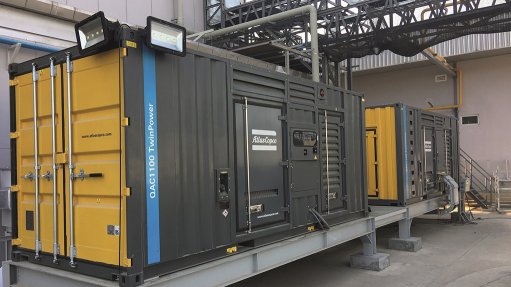
Two fully loaded Atlas Copco generators housed in one 20-foot container
A single container housing two fully loaded generators has been designed to provide reliable and flexible prime and critical standby power solutions for utilities, rental, construction, mining, quarrying, and oil and gas applications with variable load requirements.
The modular solution from Atlas Copco allows the two generators to work independently or in parallel with each other, providing multiple solutions and combinations between prime and standby use, one unit working at 50 Hz and the other at 60 Hz.
“By containerising two QAC generators side by side and packaging up to 1 MW of predictable power on a single platform, we have doubled the power and the flexibility offering to our customers and end-users. To add even more value, we have designed these generators with the objective to provide customers with the opportunity to choose the power solution best suited for those applications with changeable power and current usage requirements,” explains Atlas Copco Power Technique business line manager: portable products David Stanford.
For handling even larger projects, the QAC 1350 TwinPower has two dedicated Atlas Copco controllers Qc4004, including touchscreen Qd1001 functionality, designed to enable end-users to easily parallel with other generators. Alongside the choice of island mode or using the Power Management System (PMS), it is also possible to run the units in parallel with mains, peak shaving, fixed power and AMF. The TwinPower concept also allows one generator to run at 50% while the other is being serviced, offering end-users a built-in backup as standard and ensuring 24/7 power supply.
The QAC generator aims to deliver maximum power with minimal fuel consumption and a smart electric variable speed drive motor-driven cooling fan adjusts the cooling flow to the specific requirements of the engine, further reducing operational costs. The company highlights that the load acceptance ability of the generators is thanks to the engine/alternator performance which, in association with its respective advanced control systems, is able to accept a 100% load step with more than 70% load step acceptance within ISO 8528-G3 class respectively. Stanford also points out that with a fuel saving of up to 10%, the performance of these generators is equal to or even better than the conventional single engine generator running under normal load. This efficiency also helps to reduce customers’ carbon footprint. The spillage free frame, which can contain 110% of the fuel tank capacity, further reduces the impact on the environment.
The Stage V compliant QAC 1350 TwinPower also offers up to 85% reduction in nitrogen oxide emissions and a low noise level of 70 dB(A) at 7 m and a touch screen with easy functionality, helping to create a safe and comfortable work space. Featuring a compact footprint and equipped with solid lifting eyes and forklift inlets, the 20-foot ISO-certified container can be easily moved between worksites or safely positioned on site.
The QAC generators are said to require less than two hours of service after 500 hours of operation, while large access panels and custom service tools allow for easy maintenance, while the strategic positioning of the two generators’ engines and alternators on opposite sides of the platform facilitate fast and easy access to major components. Heavy-duty dual stage fuel and air filtration is included as standard, to ensure longer up-time and extended service intervals. The slide in/out base frame facilitates the removal of the aggregate engine from the container for maintenance and other operational tasks.
The containerised generators are designed to be robust and suited for use in extreme temperatures and at high altitudes. Atlas Copco asserts that the QAC’s intelligent engine/alternator cooling system guarantees 100% power at 40°C at an altitude of 1 000 m.